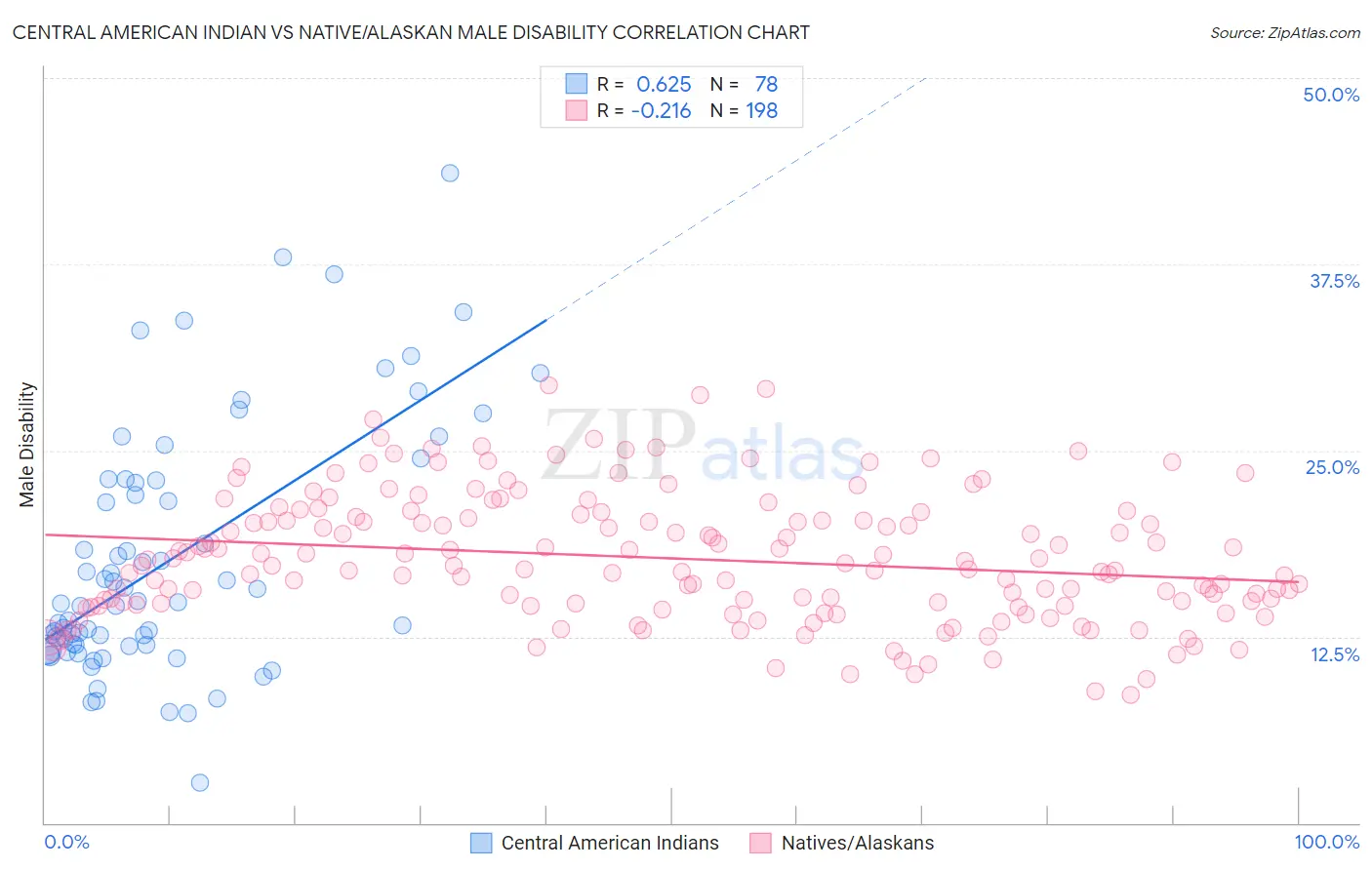Central American Indian vs Native/Alaskan Male Disability
COMPARE
Central American Indian
Native/Alaskan
Male Disability
Male Disability Comparison
Central American Indians
Natives/Alaskans
12.7%
MALE DISABILITY
0.0/ 100
METRIC RATING
278th/ 347
METRIC RANK
14.2%
MALE DISABILITY
0.0/ 100
METRIC RATING
326th/ 347
METRIC RANK
Central American Indian vs Native/Alaskan Male Disability Correlation Chart
The statistical analysis conducted on geographies consisting of 326,112,546 people shows a significant positive correlation between the proportion of Central American Indians and percentage of males with a disability in the United States with a correlation coefficient (R) of 0.625 and weighted average of 12.7%. Similarly, the statistical analysis conducted on geographies consisting of 512,854,069 people shows a weak negative correlation between the proportion of Natives/Alaskans and percentage of males with a disability in the United States with a correlation coefficient (R) of -0.216 and weighted average of 14.2%, a difference of 12.1%.

Male Disability Correlation Summary
| Measurement | Central American Indian | Native/Alaskan |
| Minimum | 2.7% | 8.6% |
| Maximum | 43.7% | 29.4% |
| Range | 40.9% | 20.8% |
| Mean | 17.7% | 17.8% |
| Median | 14.8% | 17.3% |
| Interquartile 25% (IQ1) | 11.9% | 14.7% |
| Interquartile 75% (IQ3) | 23.0% | 20.5% |
| Interquartile Range (IQR) | 11.0% | 5.9% |
| Standard Deviation (Sample) | 8.4% | 4.3% |
| Standard Deviation (Population) | 8.3% | 4.3% |
Similar Demographics by Male Disability
Demographics Similar to Central American Indians by Male Disability
In terms of male disability, the demographic groups most similar to Central American Indians are Slovak (12.7%, a difference of 0.15%), Dutch (12.7%, a difference of 0.20%), Sioux (12.7%, a difference of 0.26%), Irish (12.7%, a difference of 0.31%), and German (12.7%, a difference of 0.32%).
| Demographics | Rating | Rank | Male Disability |
| Scandinavians | 0.1 /100 | #271 | Tragic 12.3% |
| Hmong | 0.0 /100 | #272 | Tragic 12.5% |
| Native Hawaiians | 0.0 /100 | #273 | Tragic 12.5% |
| Hopi | 0.0 /100 | #274 | Tragic 12.5% |
| Fijians | 0.0 /100 | #275 | Tragic 12.6% |
| Africans | 0.0 /100 | #276 | Tragic 12.6% |
| Finns | 0.0 /100 | #277 | Tragic 12.6% |
| Central American Indians | 0.0 /100 | #278 | Tragic 12.7% |
| Slovaks | 0.0 /100 | #279 | Tragic 12.7% |
| Dutch | 0.0 /100 | #280 | Tragic 12.7% |
| Sioux | 0.0 /100 | #281 | Tragic 12.7% |
| Irish | 0.0 /100 | #282 | Tragic 12.7% |
| Germans | 0.0 /100 | #283 | Tragic 12.7% |
| Spanish | 0.0 /100 | #284 | Tragic 12.7% |
| Welsh | 0.0 /100 | #285 | Tragic 12.7% |
Demographics Similar to Natives/Alaskans by Male Disability
In terms of male disability, the demographic groups most similar to Natives/Alaskans are Potawatomi (14.2%, a difference of 0.10%), Chippewa (14.3%, a difference of 0.53%), Ottawa (14.1%, a difference of 0.94%), Comanche (14.1%, a difference of 1.1%), and Cajun (14.4%, a difference of 1.1%).
| Demographics | Rating | Rank | Male Disability |
| Americans | 0.0 /100 | #319 | Tragic 13.8% |
| Tlingit-Haida | 0.0 /100 | #320 | Tragic 13.8% |
| Shoshone | 0.0 /100 | #321 | Tragic 13.8% |
| Apache | 0.0 /100 | #322 | Tragic 14.0% |
| Osage | 0.0 /100 | #323 | Tragic 14.0% |
| Comanche | 0.0 /100 | #324 | Tragic 14.1% |
| Ottawa | 0.0 /100 | #325 | Tragic 14.1% |
| Natives/Alaskans | 0.0 /100 | #326 | Tragic 14.2% |
| Potawatomi | 0.0 /100 | #327 | Tragic 14.2% |
| Chippewa | 0.0 /100 | #328 | Tragic 14.3% |
| Cajuns | 0.0 /100 | #329 | Tragic 14.4% |
| Navajo | 0.0 /100 | #330 | Tragic 14.4% |
| Tohono O'odham | 0.0 /100 | #331 | Tragic 14.6% |
| Seminole | 0.0 /100 | #332 | Tragic 14.7% |
| Yuman | 0.0 /100 | #333 | Tragic 14.7% |